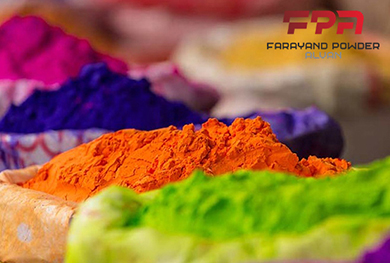What are mineral pigments? Currently, which mineral pigment is the most widely-used?
Nowadays, there is growing attention on the use of pigments, especially in paint, plastic, textile, fertilizer, and other industries. Selecting the right pigment is essential for a business to make decisions about output quality. Therefore, the goal is to obtain a deeper insight into this product and use this experience for selection.
Industrial Pigments:
Industrial pigments are chemicals compressed into powdered colorants. They have good dispersion and insolubility in the dispersion medium and are mixed with solutions such as paints and resins to color the final product.
Currently, there is a wide range of industrial paints available in different forms, such as powder, wax, and liquid. However, the powdered form is preferred due to its major advantages, such as:
Ease of Use: As a powder, it should simply be mixed with the colorant without complex preparation and special expertise.
Ease of Warehousing and Shipping: Simply keep pigments in plastic or glass containers in a dry place away from light. This product is hard to contaminate (unlike wax and liquid).
Low Price: This is the cheapest pigment among industrial paints.
Classification: There are two main types of industrial pigments.
- Organic Paint: Solid powder mixtures that produce various colors. These include:
Azo Pigment (-N=N-): These paints are mainly used in the plastic industry due to their full dissolution in water. However, azo pigments leak easily and are often combined with either metal ions or functional groups such as amide (-NHCO-) for improved migration resistance. They are typically available in yellow, orange, and red.
Phthalocyanine Pigment [-C6H4(CN)2]: Commonly known as copper phthalocyanine, the major advantages of these pigments include water resistance, good thermal resistance, standard commutativity, acidity, and alkalinity, leading to their widespread use in many industries. These pigments are typically available in blue and dark green.
Anthraquinone Pigment: This is the most widespread color of the alizarin family (orange-red compounds with luminous crystals). They are widely-used in the textile industry.
Chromatin Pigment: This transitioning pigment is used in plastics with a glass transition temperature higher than room temperature, such as PS, PMMA, and UPVC.
Advantages: Organic pigments are characterized by transparency, freshness, and high color stability (stable temperature and acidic and alkaline resistance).
Disadvantages: Organic pigments are more expensive than mineral pigments and are also susceptible to oxidation under light and easily affected by weather factors.
- Mineral Pigments: These ferrous metals or insoluble metal salts are available in white (TiO2), black (carbon black), and mineral pigments.
Titanium oxide white (TiO2): Widely used in the plastic industry, there are two types of titanium oxide, paint and non-paint. Coating power is the paint’s ability give the underlying color a matte finish. There are several factors of matting or coating power, including: 1) selected color, 2) paint quality, and 3) paint thickness.
- Non-paint white powder: Since it can result in murkiness due to its low reflectivity, it is used as filler and is relatively inexpensive. Commonly non-paint white materials include calcium carbonate, talc, clay, and silica.
- Paint white powder: With its high reflection coefficient, it can make plastic products murky. Given the high UV absorption capacity of its most important ingredient, TiO2, this titanium oxide creates a murky white color (maximum reflection, minimum absorption) with good aging resistance and non-toxicity. Moreover, commercial white pigments include zinc oxide (ZnO), zinc sulfite (ZnSO3), lithophane (a mixture of ZnS and BaSO4), tin oxide, and more.
- Black: Carbon black (charcoal black) is the most widely-known pigment of this class. It is the most important black pigment that is used extensively in the plastic industry (after TiO2). Furthermore, carbon black can improve the electrical conductivity or insulation of polymers. Specifically, this paint is less expensive than the undercoat.
Colored Mineral Pigments: These colors are as follows:
Iron oxide: They are the most important colors in the mineral pigment system and are available from yellow to red, brown, and black. These pigments are produced from natural minerals or synthetic minerals. Examples of iron oxides include: Red iron oxide (hematite or Fe2O3 in crystalline form), yellow iron oxide (iron oxide hydroxide-FeO(OH), commonly known as goethite), brown iron oxide (mixture of FeO and Fe2O3).
Iron oxide paint stands out for its durability, matte finish, excellent UV resistance, and low cost. However, it has poor color intensity and brightness, leading to limited use.
Chromium Oxide (Cr2O3): It is a single-oxide deep-green paint but with poor painting ability and heat resistance.
Mixed-Phase Oxide: Resistance to heat and different weather conditions, color stability, and relative brightness. Typical colors include cobalt blue aluminates, gold, antimony, and titanium.
Lead Chromate Powder: Available from green-yellow to yellow-red, this powder provides weather-resistance and bright color and is mostly used in the paint industry.
Rich Blue (Deep-Sea): Fermi is a bright, heat-resistant, and slightly avid-resistant complex of zeolite (sodium aluminosilicate). It is used extensively and given a very bright green-red color in resin.
Advantages: Mineral pigments typically last long under light and weather factors and are highly-resistant to heat and solubles. They are also less expensive than organic pigments.
Disadvantages: They are not as bright as organic pigments.
Other Organic Pigments:
In addition to the aforementioned organic and mineral pigments, there are also the following special paints:
- Metallic Paints: The important ingredient in these paints is their dispersed aluminum, where colors are used in combination with metallic colors or organic pigments that produce a new metallic effect.
- Iridescent paint is typically dispersed in a liquid plasticizer or resin since dry aluminum metal tends to explode. When spreading iridescent paint onto polymer substrates, shear force must be reduced to avoid structural failure or alterations that change the color effect.
- Fluorescent Paint: These paints have the special ability to convert UV light into the visible light spectrum. They have very variegated shades due to their extremely high reflection.
- Nacre Paint: The most important pigment in this category are thin mica flakes coated with TiO2, which are partly reflective and partly transparent. The simultaneous reflection of multiple layers with different biases produces an iridescent color. The right grading produces a distorted color. When mixing these paints with plastic, the mixture speed should be adjusted to prevent the flaky structure from failing.
Select industrial pigments carefully.
After a detailed review of industrial paints, the question arises: How to optimize the selected option for a particular color? For the right answer, the following points should be taken into consideration:
- Selected based on your need. To prevent waste, knowledge of which color to be used for which product is essential.
- Sufficient Amount: As a matter of habit, customers typically purchase in bulk for reasonable prices. However, it is easy to waste pigments during use.
- Supplier: Nowadays, common industrial paints are widely available. To purchase products that meet quality standards requires finding a reputable supplier.
........................................................................................................
With over 30 years of experience in producing various industrial micronized powders and an experienced team with extensive knowledge of pigments, Farayand Powder Co. has been a reputable supplier in various industries and is honored to provide technical consultation to customers for the best and most economical solutions.


